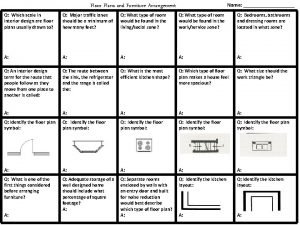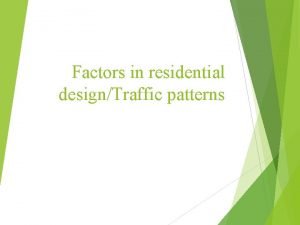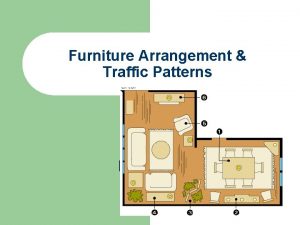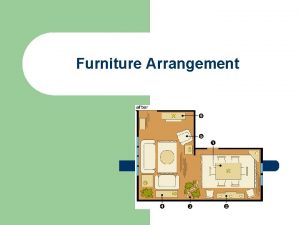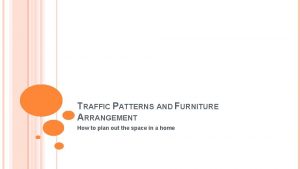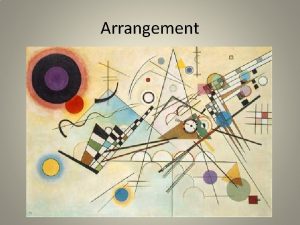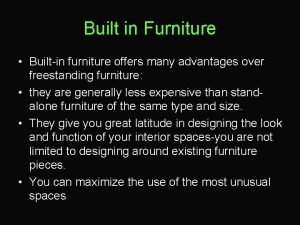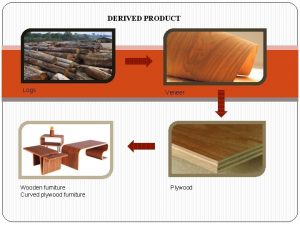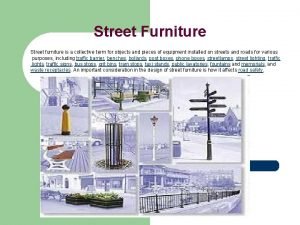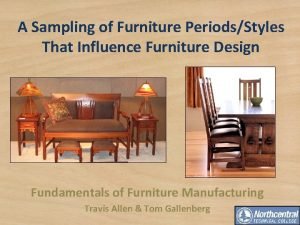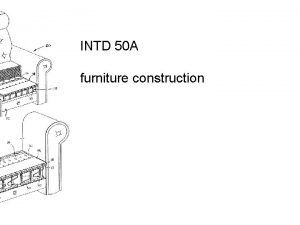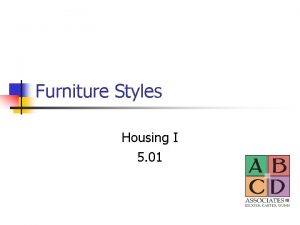Furniture Arrangement Traffic Patterns Identifying the 3 main




















- Slides: 20

Furniture Arrangement & Traffic Patterns

Identifying the 3 main zones of the home… There are 3 main zones in every home: living, sleeping, and service. When laying out the floor plan, consider these zones and the activities that take place in those zones. Quiet and private zones should be separated from noisy and public zones.

Living Zones The living area of the home includes the living, dining, family room, foyers, and specialty rooms such as those for music, study, hobby, etc. Primary conversation area: 8 -12 foot diameter is ideal; seating for at least 4 -6 people; chairs seat 1, loveseats seat 2, and sofas seat 3 Secondary furniture grouping: seating for just 1 -3 people (piano, desk, etc. ) Traffic: the traffic pattern should flow TO the conversation area, but not THROUGH it Dining area: allow 3 feet from the table edge for the person to be seated at the table and room behind them for traffic; each person is allowed a minimum of 24 inches of seating room at the table

Sleeping Zones The sleeping area of the home includes the bedrooms, bathrooms, and dressing areas. Never place the side of a bed against a wall; you always allow room to walk on both sides Storage is a key factor in these rooms: personal items, clothing, accessories, bed and bath linens, medications Allow one nightstand person sleeping in the room A chest of drawers is usually taller and has no mirror; a dresser is usually shorter and does have a mirror Twin/single beds are for 1 person; double, queen, and king can accommodate 2

Service Zones The service areas of the home include the kitchen, utility rooms, garage, and basements. Storage is a key factor in these areas, for consumable supplies (food, laundry soap, motor oil, furnace filters) and equipment Traffic should flow to the area, but not through it Utilities such as furnaces and hot water heaters need clearances for ventilation and maintenance/repair Efficiency must be considered: efficiency is a desirable degree of energy expended to achieve effective or useful output Safety must be considered: environmental (ice, lightening, storms), mechanical (cars, furnaces, electrical, plumbing, tools) chemical (cleaners, windshield wiper fluid, bug spray) sanitation (garbage, insect control)

Identifying the 3 main zones of the home… utility Name: ________ Using colored pencils, shade the living zones of the home with a yellow tone; the sleeping zones with a red/pink tone; and the service zones with a blue tone.

Traffic Patterns People move throughout the home every day, usually walking in the shortest distance possible between two points. These walkways are referred to as traffic patterns, circulation, or traffic flow. Placement of doors and furniture influence the traffic patterns. In this apartment, the furniture arrangements are used to help direct the traffic. Traffic flows smoothly through the rooms. While walkway patterns take the people to the living and work areas of the home, it doesn’t take them through those areas unless they need to be there.

Traffic Patterns… There are 4 types of traffic patterns: Service circulation includes how people move in and out of the house to make deliveries, maintain appliances, and take out garbage. Work circulation includes how people move from the kitchen to the dining areas, the kitchen triangle (a triangle connecting the refrigerator, stove, & sink), and from the bedrooms to the utility room. No cross traffic should be allowed to interfere with work circulation. Family circulation includes traffic between bedrooms and bathrooms, foyers and living rooms, foyers and bedroom areas, living rooms and patios, living rooms and dining rooms. Guest circulation includes from the entry to the coat closet, from the entry to the living room, and from the living room to the bathroom. Guests should not need to cross work or private family areas.

Identifying Traffic Patterns… Use colored pencils to draw the 4 types of traffic patterns on each floor plan below… yellow for service circulation, red for work circulation, blue for family circulation, and green for guest circulation. Which floor plan appears to have the better traffic circulation? Explain. ______________________________________________________________________________________ ___________________________ Name: __________

Traffic Pattern Clearances Traffic areas need clearance for one or more people to walk and for the people to accomplish a variety of tasks. There are major and minor traffic patterns. Major traffic patterns need 36”- 6’ clearance: hallways; area in front of clothes closets, dressers, and chests of drawers; any route where 2 people might pass each other; area in front of stove, refrigerator, sink, washer, and dryer areas; from the edge of a dining room table to a wall or stationary object; side of bed you get in on; best for stairways Minor traffic patterns need 18” – 4’ clearance: sides of beds used only for making beds; space between sofas and coffee tables; 30” in routes where only one person will walk, such as in front of tubs or through doorways

Using a Furniture Template You can either draw furniture using a ruler, or you can use an architect’s template. A template is simply a plastic pattern of commonly used architectural symbols that is made to scale and can be easily traced. There are templates for fixtures and furnishings. When adding furniture to a room, you need to think about the people that are living in that space. What are their needs? How do they move about in the space?

Drawing fixtures and furnishings in bathrooms… Shower is 30 -36” square or rectangular; rarely free-standing in new construction (so is built-in with walls); some corner units; has swinging or sliding doors or curtains Depth of vanity is 18” minimum, up to 24” A toilet needs to be centered along a 4’ section of wall 24” wide tank 28” from front of seat to wall The width of the vanity must be at least 18”, and increases in standard increments of 3” to any desired size; a round 18” diameter sink and fixtures will just fit with no room on the back or sides; height of the vanity would be either 30 or 36” 12” tank depth One edge of tub may be wider to accommodate tub doors or curtain 30– 36” depth; fixtures on square end The tub is 5’ wide; add an X for a tub/shower combination

Perfect Bathroom Arrangement To be considered a “full bath”, the room must have a toilet, vanity with sink, and bathtub. A ¾ bath has a shower instead of a tub. A half bath has only a toilet and vanity. A water closet has only a toilet, with handwashing facilities in an adjoining area. A built-in tub or shower has 6” walls on 3 sides. A window is not a requirement in a bathroom. If one is used, place it carefully. Placed above a sink prohibits the use of a mirror; placed above the tub may create a water problem with the window covering; placed where it is here may be a privacy issue. The FHA (Federal Housing Authority) recommends a minimum 5 x 7’ size for a bathroom. A perfect arrangement, however, requires a bigger room. The tub and a linen closet will be on one side of the door; the vanity and toilet will be on the other. Try to position the toilet so it is not easily visible from the open door. (here it is partially concealed behind the vanity)

Avoid bathroom design problems… The traffic pattern in a bathroom should be 30” wide. There should be at least 30” in front of the tub or shower, toilet, or sink. A wavy line is used to illustrate a shower or tub curtain Always think about where the toilet paper holder will be placed. It is never appropriate to place it on the back wall beside the tank. It should be placed to the side. Here, it can be either on the wall or the side of the vanity. A room door and closet door can open up against each other, as shown here. Notice this gap left between the end of the vanity and the wall? It is hard to clean (dust bunnies collect here) and a waste of very expensive space. This is poor design!

Newer Bathroom Designs… Large whirlpool tubs, pedestal sinks, heated stone floors, coffee services, make -up vanities, and large walkin showers are among nicer bathroom designs. This is a “compartmented bath”. The toilet is actually in a room by itself, so one person can be using the sink while the other uses the toilet. Some compartmented bathrooms have the tub in a separate room.

Design a bathroom… 1. Using ¼ inch graph paper, draw the following bathroom, 8 x 8’ square, with a 2’ window and 30” door. 2. Design a second bathroom, using the room plan below. It should measure 5 x 11’, and should also have a 30” door. When all the plumbing is close together, it is economical. In this plan, it can all be along one wall. ____ 3. Design a 3 rd bathroom, a luxury bathroom - 250 sq. ft. maximum. The exterior walls must end up forming a rectangular shape. You must incorporate at least 36 inches of lowered counter space and seating for a makeup area. This is illustrated with a dotted line_ _ _ _______ Name: _______

Drawing fixtures and furnishings in bedrooms… Remember, you draw furnishings as if looking “down” on them. Catalogs are a good source for dimensions. Beds do not need to be shown with pillows Twin & Double: 6’ Queen & King: 6 ½’ Nightstands: 1 person in the room; 18” min. in length and width (up to 30”) Chest of Drawers: 5’ tall and just 1824” deep Dresser: 30” tall; same depth Twin: 3’, Double: 4 ½’ Queen: 5’, King: 6’ Small chairs: 18” square large chairs: 36” square Dresser w/mirror: 4 -8’ wide Chest of Drawers: 3 -5’ wide Sofa: 30” wide x 6’ long; Loveseat: 30” wide x 5’long

Mechanical & Architectural Functions… Mechanical or architectural functions that must be considered when placing furniture: Air circulation vents, doors, windows, electrical outlets, phone jacks, television cables or antenna lines, fireplaces, and stairs. TV 110 V and 220 V outlets Place the 110 V outlets every 6’ along the walls for convenience Telephone and Cable Jacks SD Smoke Detector (one should be placed in hallway, outside bedroom door) Incandescent and Fireplace R F Ceiling Fan Fluorescent and Recessed Light Fixtures

Design a bedroom… Draw the bedroom suite below, using the dimensions given, including an adjoining bath and walk-in closet. Add fixtures and furniture, appropriate for a master bedroom. Not all specifications have been given, to allow you flexibility in your design. The measurements provided are “interior” measurements. The bedroom must have at least one window. Add all doors, including one out to the private patio. Show closet rods and a few hangers. 8’ Add telephone and cable TV jacks, as needed. Master Bedroom 16’ 5’ Private Patio 13’ Put bathroom and walk-in closet in these two rooms, as you feel appropriate. To hallway Other mechanical or architectural symbols are not required, but may be added if desired. Be sure to include any furniture for outdoor living, on the patio.

Furniture Arrangement & Traffic Patterns The End
 Identifying and non identifying adjective clauses
Identifying and non identifying adjective clauses Identifying and non identifying adjective clauses
Identifying and non identifying adjective clauses Identifying and non identifying adjective clauses
Identifying and non identifying adjective clauses Name arrangement
Name arrangement Incomina
Incomina All traffic solutions
All traffic solutions Traffic flow floor plan
Traffic flow floor plan Partially concealed
Partially concealed Contemporary dating patterns are formal patterns
Contemporary dating patterns are formal patterns X videos
X videos Poetic feet chart
Poetic feet chart Syllable poems
Syllable poems 5 feet in meters
5 feet in meters Expressing future
Expressing future Example of main idea
Example of main idea Void main int main
Void main int main Hình ảnh bộ gõ cơ thể búng tay
Hình ảnh bộ gõ cơ thể búng tay Frameset trong html5
Frameset trong html5 Bổ thể
Bổ thể Tỉ lệ cơ thể trẻ em
Tỉ lệ cơ thể trẻ em Chó sói
Chó sói



